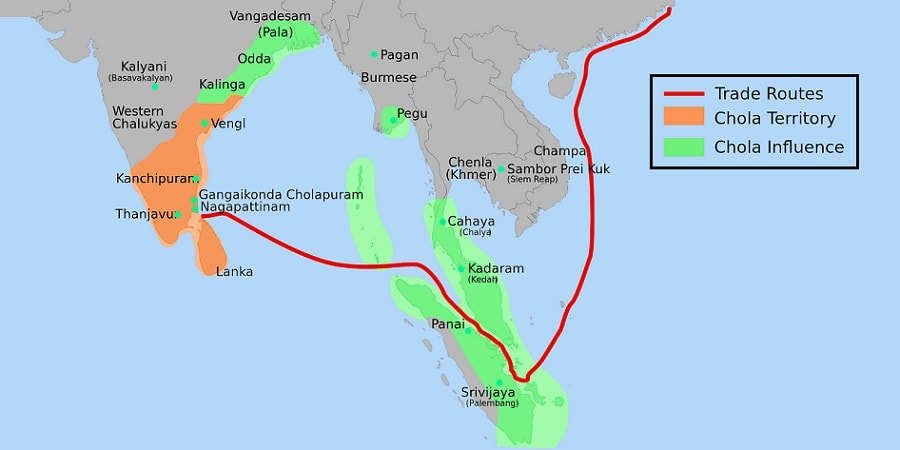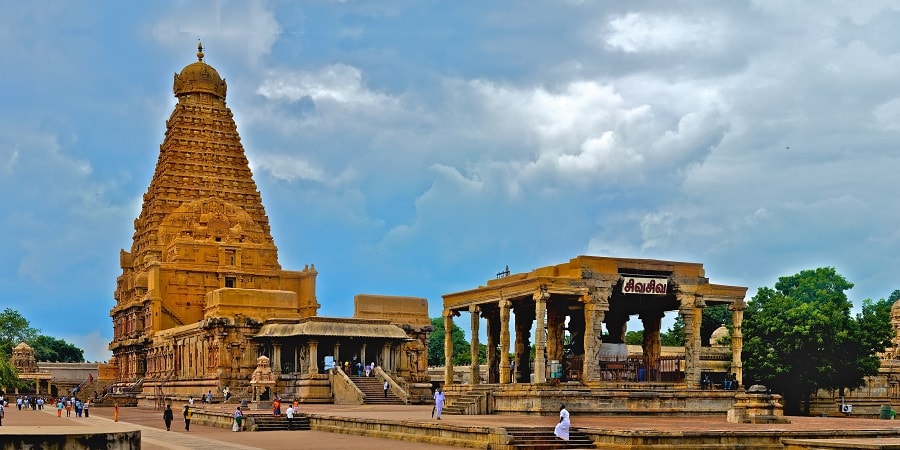Contents
>>>>>>
- Chola dynasty was a Tamil dynasty of southern India.
- They are one of the longest-ruling dynasty in history.
- The earliest references of the Chola dynasty can be traced from Sangam Age.
- Heartland of the Chola kingdom was the valley of Kaveri River.
>>>>>>>

>>>>>>>>
Chola Dynasty Kings
Vijayalaya Chola (848–871)
- Vijayalaya was the founder of Chola Dynasty.
- He captured Tanjore from Muttarayar, an ally of the Pandyas, around 850 AD.
- He founded the temple of Nishumbhasudini (Durga) in Thanjavur, Tamil Nadu.
- They were feudatories of the Pallavas.
Aditya Chola (891–907)
- Aditya Chola defeated and murdered his Pallava overlord Aparajita and occupied the entire Tondaimandalam.
- He conquered the Kongu country as well.
- He is said to have built Siva temples on both banks of the Kaveri river.
Parantaka I (907–950)
- At the start of his reign, Parantaka I invaded the Pandya territory.
- Parantaka I assumed title of ‘Maduraikonda’ (Conqueror of Madurai).
- Uttaramerur inscription tells about his region.
- Krishna Ill, one of the greatest Rashtrakuta rulers, defeated Parantaka in the famous battle of Takkolam (near Arkonam) in 949 AD.
Rajaraja Chola I (985–1014)
- The real greatness of the Chola kingdom began with Rajaraja Chola I.
- He is also known as Arumolivarman.
- Rajaraja Chola I defeated a confederation of the three kingdoms of Pandya, Kerala and Ceylon.
- He destructed the Anuradhapura after defeating north Ceylon.
- Rajaraja Chola I also annexed the Maldives probably for securing the trade routes of the Indian Ocean.
- He built Famous Rajeshwara / Brihadeshwara temple at Thanjavur (Dravida Style) in 1010 AD.
- Rajaraja Chola I encouraged Sailendra ruler of Srivijaya (South-EastAsia), to build a Buddhist vihara at Nagapattinam.
- The vihara was called ‘Chudamani Vihara‘.
Rajendra Chola I (1012–1044)
- Rajendra Chola defeated southern Srilanka & annexed whole Srilanka.
- He moved to north & Captured till Bengal defeating Mahipala I.
- Rajendra Chola assumed title of Gangaikonda Chola.
- He conquered Malay Peninsula & converted Bay of Bengal to Chola lake for trading purposes with China.
- He founded new capital of Chola dynasty Gangaikondacholapuram at Kaveri valley.
- Rajendra Chola also built famous Gangaikondachola Temple (Dravida style) in the new capital of Chola dynasty.
- In 1025, Rajendra Chola sent expedition to Sumatra and Malaya and defeated ruler of Srivijaya empire.
- In 1015 and 1033 Rajendra Chola I had sent diplomatic missions to China.
Rajadhiraja (1044–1054)
- Rajadhiraja suppressed rebellions in Pandya, Kerala and Ceylon kingdoms.
- He performed the virabhisheka.
- It was coronation of the victory there and assumed the title of ‘Vijayarajendra’.
Kulottunga I (1070–1120)
- Kulottunga I is the son of Rajaraja Narendra of Vengi and Chola princess Ammangadevi.
- He united the Vengi kingdom with the Chola kingdom.
- Kulottunga I sent a large embassy of 72 merchants to China.
- Suryavarman Il, the builder of Angkor Wat, sent a precious jewel to Kulottunga who then donated it to the temple of Chidambaram in 1114 AD.
- Last Chola dynasty king was Rajendra Chola III (1246–1279).
>>>>>>

>>>>>>
Chola Administration
- Chola Kingdom was divided into Mandalams or provinces.
- Mandalams were further divided into Town and Villages.
- Autonomous administration for towns and townships, known as Tankurrams.
- Town autonomy was quite similar to village autonomy and both were administered by assemblies.
- In the sabha, membership was restricted to the Brahmins of the village, or was found exclusively in a village gifted to Brahmins.
- The nagaram was found more commonly in trade centres such as cities and towns.
Public Works in Chola Kingdom
- Extensive irrigation works, roads and cities were made in the time of Chola dynasty.
- They made artificial lake (16 miles in length) near Gangaikonda Cholapuram, and constructed dams across the Kaveri river for irrigation purposes.
Trade & Diplomacy of Chola Dynasty
- Merchants, who operating locally was called swadesi and called nanadesi, who operated internationally.
- The merchants had their own settlements (nagara) with autonomous institutions of local government.
- The great ports (pattinam) also had their guilds and autonomous institutions.
- They financed local development projects, construction of temples, lent money to the Chola kings.
- Among the most powerful guilds were the Ayyavole and the Manigramam.
- Ayyavole extended to West Asia, while the Manigramam concentrated on trade with South-East Asia.




